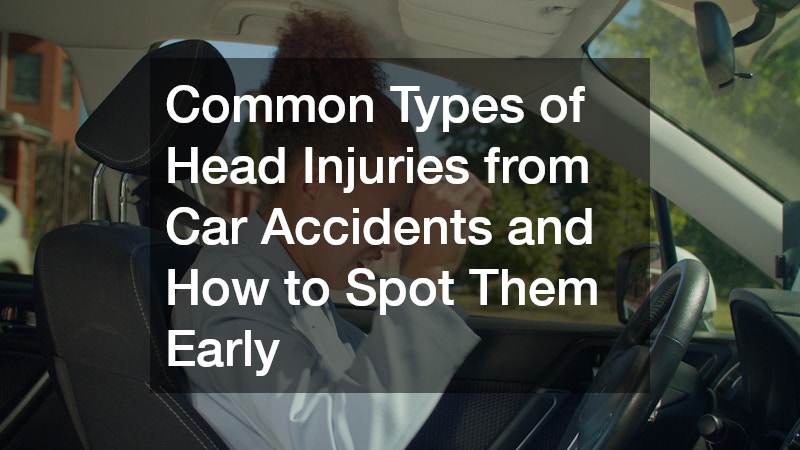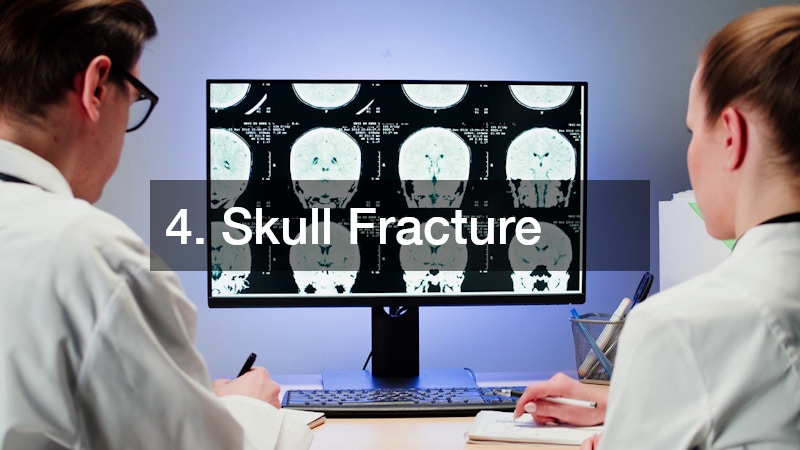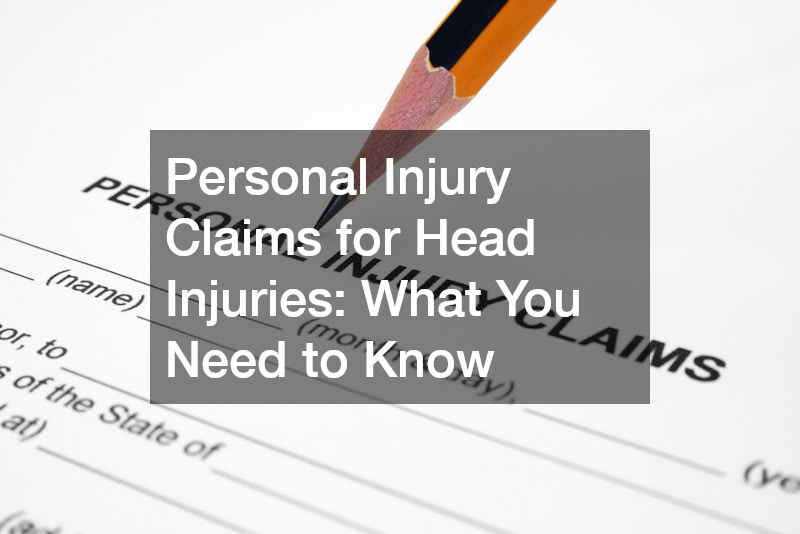
Car accidents can lead to a range of injuries, with head injuries being among the most serious. Even minor collisions can cause significant trauma to the brain, sometimes without immediate symptoms. Understanding the types of head injuries and recognizing early signs is crucial for timely medical intervention and legal action. Head injuries often have long-term consequences that can affect physical health, cognitive abilities, emotional stability, and even financial security. Knowing what to look for, what to do, and how to respond legally can be a life-saving and life-changing difference for accident victims.
What Are the Most Common Head Injuries from Car Accidents?
Head injuries from car accidents vary in severity and type. Some may present immediate symptoms, while others develop over time. Recognizing these injuries early can prevent long-term complications. The force of a crash—whether from a rear-end collision or side-impact—can jolt the brain violently within the skull, causing different kinds of trauma. Understanding each type of injury, how it presents, and how it can progress is essential for both proper medical treatment and potential legal action. The five most frequently reported head injuries in car accidents include concussions, contusions, diffuse axonal injuries, skull fractures, and penetrating injuries.
1. Concussion (Mild Traumatic Brain Injury)
A concussion occurs when the brain experiences a sudden jolt, causing it to move within the skull. This is common in car accidents due to rapid deceleration or impact. Symptoms may include:
- Headache
- Dizziness
- Confusion
- Nausea
- Sensitivity to light or noise
If not treated early and properly, concussions can have lasting effects on the patient’s overall health and well-being. Repeated concussions or delayed treatment may lead to post-concussion syndrome, where symptoms persist for weeks or months. Even a “mild” traumatic brain injury can interfere with sleep, concentration, and emotional regulation. Victims should avoid physical exertion, screen time, and driving until cleared by a doctor.
2. Contusion (Brain Bruise)
A contusion is a bruise on the brain tissue, typically resulting from a direct impact to the head. In car accidents, this can happen when the head strikes the steering wheel or window. Symptoms might include:
- Loss of consciousness
- Difficulty speaking
- Cognitive challenges
Severe contusions may require surgical intervention. Unlike a concussion, a contusion is a localized injury that can swell and put pressure on nearby brain tissue. In some cases, contusions can turn into hematomas—blood clots that need to be drained surgically. Victims might experience slurred speech, weakness in limbs, or difficulty with memory and judgment. Brain imaging is typically required for an accurate diagnosis.
3. Diffuse Axonal Injury (DAI)
DAI involves widespread damage to the brain’s white matter due to shearing forces during rapid acceleration or deceleration. This injury is serious and can lead to:
- Loss of consciousness
- Coma
- Long-term cognitive impairment
DAI is often diagnosed through imaging studies like MRI. Unlike focal injuries like contusions, DAI affects multiple areas of the brain simultaneously. It is one of the most severe types of brain injuries because it disrupts communication between brain cells. Recovery from DAI can be prolonged and may require long-term rehabilitation involving speech therapy, occupational therapy, and psychological support. It often results in permanent disability.
4. Skull Fracture

Depending on the severity, a skull fracture or a break in the cranial bone can lead to:
- Bleeding
- Brain damage
- Infection
Signs include swelling, tenderness, and visible deformities. There are different types of skull fractures: linear (a thin crack), depressed (a portion of the skull sinks in), and basilar (a fracture at the base of the skull). These injuries can compromise the integrity of the brain’s protective barrier, allowing bacteria to enter and cause infections like meningitis. Some fractures also cause cerebrospinal fluid (CSF) leaks, which are identified by clear fluid draining from the nose or ears.
5. Penetrating Head Injury
This occurs when an object pierces the skull and enters the brain tissue. In car accidents, this might result from debris or shattered glass. Such injuries are life-threatening and require immediate medical attention. Penetrating injuries can lead to severe bleeding, infection, and permanent brain damage, depending on the affected area. Surgery is often required to remove the object and control swelling. Survivors may experience long-term effects such as memory loss, motor skill impairment, or emotional regulation issues.
How to Spot Early Signs of Head Injuries After a Car Accident
Early detection of head injuries is vital. Some symptoms may appear immediately, while others develop over hours or days. Be vigilant for the following signs:
- Persistent headache
- Nausea or vomiting
- Dizziness or balance issues
- Blurred vision
- Sensitivity to light or noise
- Confusion or memory loss
- Changes in mood or behavior
These symptoms are often dismissed as stress or shock-related, but they may signal underlying brain trauma. Any changes in cognitive function, personality, or physical coordination should prompt an urgent visit to the emergency room. Never assume that someone is “okay” just because they are conscious and talking.
Additional Warning Signs to Monitor in Children and Older Adults
Head injuries can present differently in children and seniors. In children, watch for:
- Crying that doesn’t stop
- Vomiting
- Refusal to eat or sleep
- Irritability or drowsiness
For older adults, symptoms may include:
- Increased confusion
- Trouble walking
- Loss of bladder control
- Slurred speech
Both age groups may be at higher risk for complications, so err on the side of caution and seek medical care immediately after a crash, even if no outward injuries are obvious.
Types of Head Injuries from Car Accidents and Their Long-Term Effects
Understanding the potential long-term consequences of head injuries can underscore the importance of early detection and treatment. Damage to the brain can lead to lasting impairments that affect personal independence, career, and relationships. While some victims recover fully, others may face years of cognitive rehabilitation, medication management, or therapy. The emotional toll on both the patient and their loved ones is often significant.
Cognitive Impairments
Injuries like concussions or DAI can lead to difficulties with:
- Memory
- Attention
- Problem-solving
- Language skills
These challenges can affect daily functioning and quality of life. Individuals may struggle with work, school, or basic tasks like grocery shopping or managing finances. Cognitive rehabilitation therapy can help retrain the brain, but progress is often slow and depends on the severity of the injury.
Emotional and Behavioral Changes
Head injuries may result in:
- Depression
- Anxiety
- Irritability
- Mood swings
Such changes can strain personal relationships and hinder recovery. Brain injuries often alter how the victim perceives and interacts with the world. Loved ones may notice personality shifts or emotional instability. Mental health support is essential to help manage these emotional challenges and rebuild interpersonal relationships.
Physical Disabilities
Severe injuries might cause:
- Paralysis
- Chronic pain
- Seizures
These conditions often require long-term medical care and rehabilitation. Victims might also experience speech impairments, muscle weakness, or coordination problems. Assistive devices, in-home care, and ongoing therapy become essential for recovery. Some individuals may never regain full independence and need a support system to manage daily activities.
The Importance of Medical Evaluation and Documentation
After a car accident, even if no symptoms are immediately apparent, it’s crucial to:
- Seek medical attention
- Undergo imaging tests like CT scans or MRIs
- Follow up with healthcare providers
Proper documentation of injuries is essential, especially if pursuing a personal injury claim. Accurate medical records provide proof of injury, link the injury to the accident, and serve as evidence in negotiations or litigation. Delays in treatment can weaken your legal case and worsen your health. Always keep copies of all test results, prescriptions, and doctor’s notes.
Personal Injury Claims for Head Injuries: What You Need to Know

If you’ve sustained a head injury due to another party’s negligence, you may be entitled to compensation. Here’s what to consider:
Establishing Liability
Proving that another party was at fault is the first step. This involves:
- Gathering evidence (e.g., accident reports, witness statements)
- Demonstrating negligence
In many cases, fault may lie with a distracted driver, a commercial trucking company, or even a manufacturer if a defective part contributed to the crash.
Documenting Damages
Keep detailed records of:
- Medical treatments and expenses
- Lost wages
- Pain and suffering
These records support your claim and help determine appropriate compensation. Photos of injuries, expert opinions, and written statements from caregivers or employers can strengthen your claim and demonstrate how the injury has affected your daily life.
Legal Representation
Consulting with a personal injury attorney can:
- Provide guidance through the legal process
- Negotiate with insurance companies
- Advocate for fair compensation
An experienced attorney understands the complexities of brain injury claims and will ensure no detail is overlooked—from calculating future medical costs to working with neurologists and vocational experts.
Steps to Take After a Car Accident Involving Head Injury
Immediate actions can influence both health outcomes and legal claims:
- Seek Medical Attention – Even if symptoms are absent, a medical evaluation is essential.
- Document the Scene – Take photos, gather witness information, and file a police report.
- Notify Your Insurance Company – Report the accident promptly.
- Consult an Attorney – Legal advice can help protect your rights and interests.
Delaying any of these steps may harm your physical recovery and reduce your chances of receiving full compensation.
Conclusion
Head injuries from car accidents can have profound and lasting effects. Recognizing the types of injuries and their symptoms is crucial for timely medical intervention. Moreover, understanding the legal avenues available can ensure that victims receive the compensation they deserve. If you or a loved one has experienced a head injury due to a car accident, prioritize health, seek immediate medical evaluation, and consult a personal injury attorney to navigate the path to recovery and justice. Time, knowledge, and the right professionals can make all the difference.





